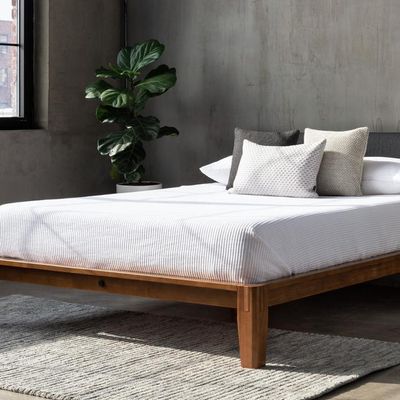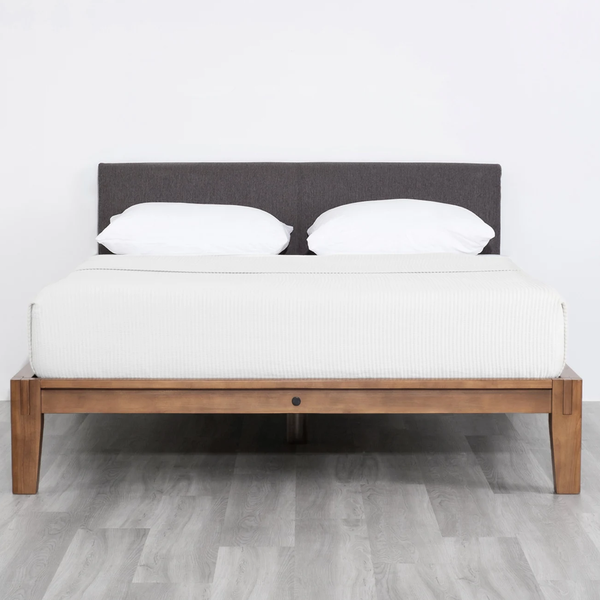
The last time I moved into a new apartment, there were two questions keeping me up at night: (1) How I was going to disassemble my metal 14-piece bed frame (for which I’d long lost the instruction manual), and (2) how I was going to reassemble it once I got to my new place. I’m far from handy — and prone to tears when left alone with an Allen wrench and a poorly printed diagram — so much so that I once paid my former roommate $10 to reattach the legs on a desk I’d purchased from Craigslist. I despise assembling furniture so much, in fact, that I’d begun debating calling off the move altogether, not yet ready to face the very specific humiliation that is trying to discern “bolt A” from “bolt B.” But unless I wanted to drive to a furniture store, pick out a pre-assembled bed frame for the price of one month’s rent, and carry it up three flights of stairs into my tiny apartment, it was DIY or nothing.
A quick Google search for “easy-to-assemble bed frame” resulted in similar models to the one I’d owned: frames that required assembly with bolts and hex keys and some degree of spatial ability. And for every reviewer who claimed an Ikea bed was “easy to assemble,” another would call it something like “the bane of my existence” or “the reason for my divorce.”
You understand my skepticism when I started getting ads from Thuma for the Bed, a wooden bed frame that claimed to require zero tools for assembly. According to the brand, the pieces of the Japanese-joinery-inspired frame would fit together like a puzzle. The slats would fit snugly into the recessed base, and the headboard would simply slide in between the wall and the mattress — and the whole thing required just two hand-tightened screws, no screwdrivers, wrenches, or diddly-bobs required. Plus, it was beautiful (a little too beautiful, perhaps, for the under-$1,000 price): It’s made from sturdy repurposed wood, and comes in two natural finishes and a fabric-covered headboard. Assembly should take 20 minutes at most, reviewers assured, and disassembly just five. I’ll be the judge of that, I thought, and reached out to the brand to see if I could put the model to the test.
The ten-piece frame arrived in three boxes, which ranged in weight from “I could do this all day” to “Lord take me now.” (If you live in a walk-up, I’d recommend getting some help lugging them up the stairs.) Thuma recommends unwrapping each box and laying out the pieces before you get started, which — spoiler alert — was actually the most frustrating and time-consuming part of the whole process. There were boxes within boxes within boxes, all of which were difficult to open and full of plastic and paper, and the pieces took up most of my bedroom, hallway, and kitchen. The resulting heap of (recyclable!) trash took up all three cans outside of my apartment, for which I formally apologize to my super.
Once unwrapped, I set a timer and read through the instructions. (I would recommend watching the assembly video on the brand’s website, but I forgot that it existed, so I went fully analog.) As per the instructions, I started by assembling one corner of the bed, which required fitting together what were essentially three 3-D wooden puzzle pieces: the leg, and two long side beams. The pieces fit together intuitively and seamlessly — there were no gaps or ill-fitting screws — and I felt almost like a child playing with a set of fancy wooden blocks. It stood upright without needing to be propped up, and the pieces held together once in place. Only three minutes had passed, and my bed was already a quarter of the way assembled (and though I didn’t want to admit it, I was actually having fun).
Things took a turn while assembling the second corner, as one of the pieces was upside down. I would be lying if I said that I didn’t begin to panic, prepared to pay my roommate to finish building the rest. After taking another look at the (gloriously detailed) instructions however, this proved to be an easy fix. (This is something I have never once said, I should add, in the context of assembling furniture.) There was one corner for which I even got a little lazy, and just tried to fit in each side of the beam by turning it over and over, much like you try each side of a USB cable, until it finally slid snugly into place.
The slats, though heavy, were easy to unroll and secure into the recessed frame, and the headboard required no hardware at all: It simply fit into the leftover space between the frame, the wall, and the mattress. In total, assembly took 20 minutes, while unpacking and cleanup took another 30, and I’d guess that more seasoned furniture assemblers (or those with box cutters) will require even less.
Rather than on the verge of tears, I finished assembly like a kid who’d completed a beautiful wooden Rubix cube. The walnut stain was even richer in person, and the fabric cover on the headboard, I discovered, could unzip for easy washing. It was high enough for ample under-bed storage, but not so large as to overwhelm my small space. I’ve been sleeping on it for just over two months, and it hasn’t squeaked or tumbled like a Jenga tower. It’s well-made enough (and easy enough to disassemble) that I imagine I’ll bring it along with me to my next apartment. I’ll just need some help getting it down the stairs.
The Strategist is designed to surface the most useful, expert recommendations for things to buy across the vast e-commerce landscape. Some of our latest conquests include the best acne treatments, rolling luggage, pillows for side sleepers, natural anxiety remedies, and bath towels. We update links when possible, but note that deals can expire and all prices are subject to change.






